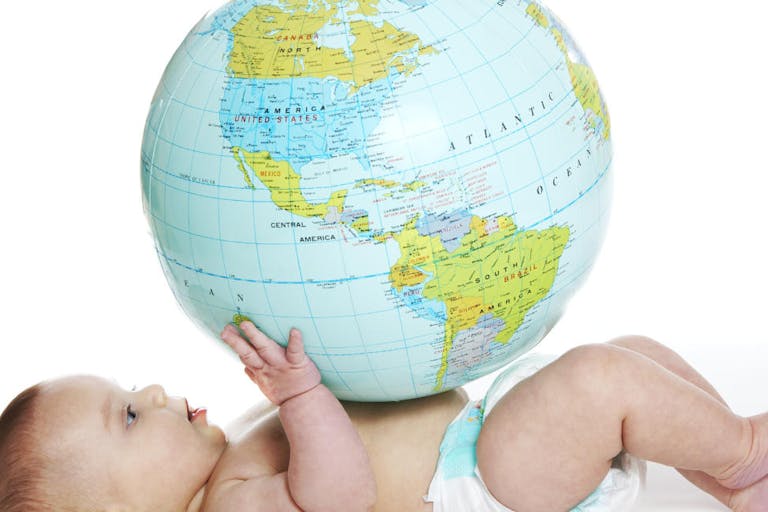
Texas library can keep sexually explicit material from minors... for now
Sheena Rodriguez
·
BLIND SPOT: UNFPA warns of ‘fertility crisis’ while insisting abortion is a ‘human right’
The United Nations Population Fund (UNFPA), which has long been connected to government agencies favoring population control, is now raising the alarm of a future “population collapse.”
In its latest state of the world population report, “The Real Fertility Crisis,” UNFPA argues in favor of “reproductive agency” — which it claims would ensure every family has the number of children they want to have, and against coercive government incentives to have or not have children.
A 14-country survey revealed to UNFPA that people largely feel hindered from exercising their “reproductive agency” to have as many children as they want. Some cite financial concerns, while others cite fears of war, pandemics, and more.
UNFPA almost appears to be shaming countries that haven’t afforded citizens ‘reproductive agency’, while the agency itself is partly to blame for heavily promoting contraception and abortion — especially in the “Global South” (Africa, Asia, Latin America, and the Caribbean).
At the same time, UNFPA praises countries like India for reducing its average family size to a third of what it once was. It appears the agency is concerned about increasing the family size for those in only certain areas of the world.
Until UNFPA acknowledges that abortion is a human rights violation, it will continue to redistribute oppression to the next generation in the name of “reproductive agency.”
UNFPA conducted a survey of 14 countries to learn if citizens are having the number of children they want to have. The report “found that alarmingly high proportions of adults are unable to realize their fertility intentions.”
Nearly 20% of adults of reproductive age believe they will be unable to have the number of children they want.
11% believe they will have fewer children than they would ideally choose.
7% believe they will have more children.
45% did not know or did not want to answer.
Reasons given for being unable to have their desired number:
39%: Financial limitations
One in five (20%): Fears about future (climate change, environmental degradation, wars, pandemics)
“I want children, but it’s becoming more difficult as time passes by,” said an anonymous 29-year-old woman from Mexico. “It is impossible to buy or have affordable rent in my city. I also would not like to give birth to a child in war times and worsened planetary conditions, if that means the baby would suffer because of it.”
Ages 50 and older were also surveyed:
31% had fewer children than they wanted
12% had more than wanted
In some cases, spouses’ differing wishes regarding children influenced how many children they had.
Across all age categories:
23% experienced a time when they wanted a child but felt unable to have one
Of these, more than 40% had to forgo their desire to have a child
Nearly 13% experienced both an unintended pregnancy and barriers to having a child
This, said the report, indicates “systems and environments are failing to support individuals’ reproductive decision-making.”
The report states that although it is largely assumed that a person’s or couple’s number of children is a matter of free choice, this is not the case for many. The report argues that there is…
“a very real crisis taking place — a crisis that requires urgent action, but often different actions than those currently being implemented. It is a crisis in reproductive agency — in the ability of individuals to make their own free, informed and unfettered choices about everything from having sex to using contraception to starting a family.”
It adds that “reproductive agency offers a pathway towards the full realization of reproductive rights.”
But at whom is UNFPA wagging its finger for not affording people their “reproductive agency”? After all, it has been a large part of the problem:
For decades, ‘anti-large family’ marketing has been spreading around the globe, with the focus of international groups and agencies (like UNFPA) and various countries on promoting contraception and abortion to avoid having children.
That marketing (or propaganda) convinced — and continues to convince — young people to delay marriage and children.
Pro-life organizations have, for decades, attempted to connect families in difficult circumstances to resources and parenting support, but the media, pro-abortion politicians, and organizations have attempted to silence them and shut them down.
These so-called advocates of “choice” have actively worked to deny women the “reproductive agency” (in the form of childbearing) that UNFPA is now arguing is their right.
After decades of promoting access to birth control and abortion in an attempt to slow the birth rate, UNFPA’s report notes:
The last century saw major advances in healthcare and development, propelling the largest population expansion in human history — one broadly viewed as a ‘population bomb’ when it came to people in the Global South.
A variety of anxieties took hold, ranging from concerns that overpopulation would stymie development and increase poverty, to the assumption that famine and mass death were unavoidable. Many leaders and advisers, especially those in developed countries, predicted a ‘race to oblivion’ unless measures were implemented to control women’s fertility (Ehrlich and Ehrlich, 1968) – too often through practices such as coerced use of contraception and forced sterilization or abortion (Hartmann, 2016).
“Global South” is a controversial term used to refer to Africa, Asia, Latin America, and the Caribbean — meaning that the UN and other organizations have been worried about certain people in certain nations and cultures having more babies than the organizations want them to have.
Is UNFPA now admitting that coercive population control (in which it participated, supporting China’s policies) was unethical and discriminatory?

The report continued, “Hindsight offers a more neutral account of this period and its impacts…” It noted:
In fact, not all countries have expressed alarm over fertility rates in the same way.
Article continues below
Dear Reader,
Have you ever wanted to share the miracle of human development with little ones? Live Action is proud to present the "Baby Olivia" board book, which presents the content of Live Action's "Baby Olivia" fetal development video in a fun, new format. It's perfect for helping little minds understand the complex and beautiful process of human development in the womb.
Receive our brand new Baby Olivia board book when you give a one-time gift of $30 or more (or begin a new monthly gift of $15 or more).
In Latin America, for example, demographic concerns are less related to rising or falling birth rates and more likely to focus on diverse demographic trends within countries, where inequalities and structural barriers can influence whether, when and how people choose to have children.
The “Global South” — largely Hispanic and Black populations — was the main target of population control efforts that those nations did not want.
In India, where 68% of the population is now of working age (15-64), the average woman gives birth to two children — down from six in 1960. The country has seen a reversal of the government’s fertility objectives.
The government once used coercive measures to sterilize men and women and curb the birth rate. India’s Andhra Pradesh State even enacted a law banning candidates with more than two children from seeking elected office.
Now, it is considering banning candidates with fewer than two children.
UNFPA appears to speak against this — yet in one breath, it says fewer children are best, using language like ‘progress’ and showing gratitude for reduced populations. In the next breath, it says everyone should be allowed to have the number of children they want to have.
“India has made significant progress in lowering fertility rates—from nearly five children per woman in 1970 to about two today—thanks to improved education and access to reproductive healthcare,” said Andrea M. Wojnar, UNFPA India Representative. “… Yet, deep inequalities persist across states, castes, and income groups. The real demographic dividend comes when everyone has the freedom and means to make informed reproductive choices.”
Which is it? Should people have fewer children, or should they have the “freedom” to make their own choices about how many children they have?

It seems there is still an effort being made to market the idea of a small family — at least among certain people groups.
At the same time, the report argues that “reproductive agency” is “a critical global priority.”
UNFPA India noted, “The report underscores that the real crisis lies not in population size, but in the widespread challenges to support individuals’ right to decide freely and responsibly if, when, and how many children to have.”
Despite numerous responses citing financial constraints as a reason for not having as many children as they want, UNFPA went on to (oddly) blame pro-life laws for people’s decisions not to have children, saying that young people are seeking permanent sterilization at higher rates out of fear that they can’t abort a baby should they become pregnant.
But those fears stem from false news reports of pregnant women dying because of pro-life laws, when in reality, pro-life laws are not at fault for women’s deaths in pro-life states; pregnant women die in pro-abortion states, as well, due to similar causes.
Amber Thurman, Candi Miller, Porsha Ngumezi, Josseli Barnica, and Nevaeh Crain all died from tragic and preventable deaths in states that had previously or have since enacted pro-life laws. But medical negligence and other factors appear to have caused their deaths, not pro-life laws.
Had news outlets investigated pro-abortion states, they would almost certainly have found similar maternal deaths.
UNFPA seems ready to promote larger families by offering a plan to “adapt to population change without sacrificing human rights.” But as long as its plan includes abortion, UNFPA’s efforts to uphold human rights will fail.
Induced abortion is a direct attack on human rights. UNFPA fails to see that what it is suggesting is that the ‘reproductive oppression’ it presumably stands against for women should be passed onto the children instead; it advocates for their murders simply because they are labeled “unwanted.”
While UNFPA is right that “[w]hether the policies are coercive or not, there are real risks to treating fertility rates as a faucet to be turned on or off,” it fails to see the major error in its own assessment.
No one’s “reproductive agency” can legitimately include intentionally killing a child who already exists and lives in his mother’s womb.
Live Action News is pro-life news and commentary from a pro-life perspective.
Contact editor@liveaction.org for questions, corrections, or if you are seeking permission to reprint any Live Action News content.
Guest Articles: To submit a guest article to Live Action News, email editor@liveaction.org with an attached Word document of 800-1000 words. Please also attach any photos relevant to your submission if applicable. If your submission is accepted for publication, you will be notified within three weeks. Guest articles are not compensated (see our Open License Agreement). Thank you for your interest in Live Action News!

Sheena Rodriguez
·
Politics
Madison Evans
·
Opinion
Nancy Flanders
·
Investigative
Carole Novielli
·
International
Cassy Cooke
·
Analysis
Nancy Flanders
·
Human Interest
Nancy Flanders
·
Investigative
Nancy Flanders
·
Pop Culture
Nancy Flanders
·
Human Interest
Nancy Flanders
·
Human Interest
Nancy Flanders
·